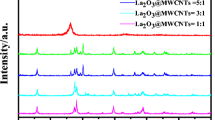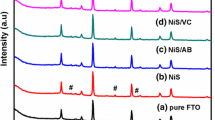Abstract
In this work, we investigated the morphology, electrical conductivity, catalytic properties, and binding energies of electronic states of a system consisting of acetylene carbon black (AB) and graphite as efficient and low-cost counter electrodes (CEs) for dye-sensitized solar cells (DSSCs), where ratios of AB to graphite of 0:1, 1:3, 1:1, 3:1, and 1:0 were investigated. These carbon-based CEs were characterized using four-point probe conductivity measurement, field emission scanning electron microscope (FE-SEM), X-ray diffraction (XRD), X-ray photoelectron spectroscopy (XPS), near-edge X-ray absorption fine structure (NAXAFS), electrochemical impedance spectrum (EIS), and current-voltage (I-V) performance. Introduction of small AB particles into graphite paste enhanced the electronic conductivity of AB-graphite composite due to the bridging of the graphite flakes for electrocatalytic activity of triiodide reduction. AB particles also offer large surface area to provide high electrochemical performance in DSSCs. The overall highest power conversion efficiency of 5.06% was achieved for the DSSC fabricated with a CE consisting of AB-graphite ratio of 3:1, which is comparable to the DSSC performance with conventional platinum (Pt) CE. These findings suggest that AB and graphite composite could be a promising CE for low-cost DSSCs.





Similar content being viewed by others
References
Nazeeruddin MK, Baranoff E, Grätzel M (2011) Dye-sensitized solar cells: a brief overview. Sol Energy 85:1172–1178. https://doi.org/10.1016/j.solener.2011.01.018
Murakami TN, Grätzel M (2008) Counter electrodes for DSC: application of functional materials as catalysts. Inorg Chim Acta 361:572–580. https://doi.org/10.1016/j.ica.2007.09.025
Dobrzański LA, Mucha A, vel PMP et al (2016) Characteristics of dye-sensitized solar cells with carbon nanomaterials. Mater Tehnol 50:649–654. https://doi.org/10.17222/mit.2014.134
Grätzel M (2003) Dye-sensitized solar cells. J Photochem Photobiol C: Photochem Rev 4:145–153. https://doi.org/10.1201/b19148
Jaafar H, Ain MF, Ahmad ZA (2018) Performance of E. conferta and G. atroviridis fruit extracts as sensitizers in dye-sensitized solar cells (DSSCs). Ionics (Kiel) 24:891–899. https://doi.org/10.1007/s11581-017-2244-1
Tsekouras G, Mozer AJ, Wallace GG (2008) Enhanced performance of dye sensitized solar cells utilizing platinum electrodeposit counter electrodes. J Electrochem Soc 155:K124. https://doi.org/10.1149/1.2919107
Wu M, Lin X, Wang T, Qiu J, Ma T (2011) Low-cost dye-sensitized solar cell based on nine kinds of carbon counter electrodes. Energy Environ Sci 4:2308–2315. https://doi.org/10.1039/c1ee01059j
Murakami TN, Ito S, Wang Q, Nazeeruddin MK, Bessho T, Cesar I, Liska P, Humphry-Baker R, Comte P, Péchy Ṕ, Grätzel M (2006) Highly efficient dye-sensitized solar cells based on carbon black counter electrodes. J Electrochem Soc 153:A2255. https://doi.org/10.1149/1.2358087
Chen M, Shao LL (2016) Review on the recent progress of carbon counter electrodes for dye-sensitized solar cells. Chem Eng J 304:629–645. https://doi.org/10.1016/j.cej.2016.07.001
Wu CS, Chang TW, Teng H, Lee YL (2016) High performance carbon black counter electrodes for dye-sensitized solar cells. Energy 115:513–518. https://doi.org/10.1016/j.energy.2016.09.052
Kouhnavard M, Ludin NA, Ghaffari BV, Sopian K, Ikeda S (2015) Carbonaceous materials and their advances as a counter electrode in dye-sensitized solar cells: challenges and prospects. ChemSusChem 8:1510–1533. https://doi.org/10.1002/cssc.201500004
Wu J, Lan Z, Lin J, Huang M, Huang Y, Fan L, Luo G, Lin Y, Xie Y, Wei Y (2017) Counter electrodes in dye-sensitized solar cells. Chem Soc Rev 46:5975–6023. https://doi.org/10.1039/c6cs00752j
Theerthagiri J, Senthil AR, Madhavan J, Maiyalagan T (2015) Recent progress in non-platinum counter electrode materials for dye-sensitized solar cells. ChemElectroChem 2:928–945. https://doi.org/10.1002/celc.201402406
Sharifi N, Tajabadi F, Taghavinia N (2014) Recent developments in dye-sensitized solar cells. ChemPhysChem 15:3902–3927. https://doi.org/10.1002/cphc.201402299
Gao Y, Chu L, Wu M, Wang L, Guo W, Ma T (2012) Improvement of adhesion of Pt-free counter electrodes for low-cost dye-sensitized solar cells. J Photochem Photobiol A Chem 245:66–71. https://doi.org/10.1016/j.jphotochem.2012.07.005
Tang YT, Pan X, Dai SY, Zhang CN, Tian HJ (2010) Research progress of the counter electrode in dye-sensitized solar cells. Key Eng Mater 451:63–78. https://doi.org/10.4028/www.scientific.net/KEM.451.63
Iqbal MZ, Khan S (2018) Progress in the performance of dye sensitized solar cells by incorporating cost effective counter electrodes. Sol Energy 160:130–152. https://doi.org/10.1016/j.solener.2017.11.060
Park YS, Kim HK (2011) The effects of annealing temperature on the characteristics of carbon counter electrodes for dye-sensitized solar cells. Curr Appl Phys 11:989–994. https://doi.org/10.1016/j.cap.2011.01.004
Mahalingam S, Abdullah H, Shaari S, Muchtar A (2016) Improved catalytic activity of Pt/rGO counter electrode in In2O3-based DSSC. Ionics (Kiel) 22:2487–2497. https://doi.org/10.1007/s11581-016-1759-1
Bu IYY, Hu TH (2016) The role of various carbon nanomaterials for dye-sensitized solar cells applications. Sol Energy 130:81–88. https://doi.org/10.1016/j.solener.2016.02.001
Yun S, Lund PD, Hinsch A (2015) Stability assessment of alternative platinum free counter electrodes for dye-sensitized solar cells. Energy Environ Sci 8:3495–3514. https://doi.org/10.1039/c5ee02446c
Kim JM, Rhee SW (2012) Electrochemical properties of porous carbon black layer as an electron injector into iodide redox couple. Electrochim Acta 83:264–270. https://doi.org/10.1016/j.electacta.2012.07.107
Imoto K, Takahashi K, Yamaguchi T, Komura T, Nakamura JI, Murata K (2003) High-performance carbon counter electrode for dye-sensitized solar cells. Sol Energy Mater Sol Cells 79:459–469. https://doi.org/10.1016/S0927-0248(03)00021-7
Wu K, Zhao J, Xiong Y, Ruan B, Wu M (2018) Synthesis and performance of La2O3@MWCNT composite materials as Pt-free counter electrodes for dye-sensitized solar cells. Ionics (Kiel) 24:4055–4061. https://doi.org/10.1007/s11581-018-2549-8
Veerappan G, Bojan K, Rhee SW (2011) Sub-micrometer-sized graphite as a conducting and catalytic counter electrode for dye-sensitized solar cells. ACS Appl Mater Interfaces 3:857–862. https://doi.org/10.1021/am101204f
Gagliardi S, Giorgi L, Giorgi R, Lisi N, Dikonimos Makris T, Salernitano E, Rufoloni A (2009) Impedance analysis of nanocarbon DSSC electrodes. Superlattice Microst 46:205–208. https://doi.org/10.1016/j.spmi.2009.02.002
Liu G, Wang H, Li X, Rong Y, Ku Z, Xu M, Liu L, Hu M, Yang Y, Xiang P, Shu T, Han H (2012) A mesoscopic platinized graphite/carbon black counter electrode for a highly efficient monolithic dye-sensitized solar cell. Electrochim Acta 69:334–339. https://doi.org/10.1016/j.electacta.2012.03.012
Peng S, Cheng F, Shi J, Liang J, Tao Z, Chen J (2009) High-surface-area microporous carbon as the efficient photocathode of dye-sensitized solar cells. Solid State Sci 11:2051–2055. https://doi.org/10.1016/j.solidstatesciences.2009.09.010
Ting CC, Chao WS (2010) Efficiency improvement of the DSSCs by building the carbon black as bridge in photoelectrode. Appl Energy 87:2500–2505. https://doi.org/10.1016/j.apenergy.2010.02.024
Jaafar H, Ahmad ZA, Ain MF (2018) The use of carbon black-TiO2composite prepared using solid state method as counter electrode and E. conferta as sensitizer for dye-sensitized solar cell (DSSC) applications. Opt Mater (Amst) 79:366–371. https://doi.org/10.1016/j.optmat.2018.04.008
Theerthagiri J, Senthil RA, Arunachalam P, Bhabu KA, Selvi A, Madhavan J, Murugan K, Arof AK (2016) Electrochemical deposition of carbon materials incorporated nickel sulfide composite as counter electrode for dye-sensitized solar cells. Ionics (Kiel) 23:1017–1025. https://doi.org/10.1007/s11581-016-1885-9
Kumara NTRN, Hamdan N, Petra MI, Tennakoon KU, Ekanayake P (2014) Equilibrium isotherm studies of adsorption of pigments extracted from Kuduk-kuduk (Melastoma malabathricum L.) pulp onto TiO2nanoparticles. J Chemother 2014:1–6. https://doi.org/10.1155/2014/468975
Xu SJ, Luo YF, Zhong W, Liu XY, Xiao ZH, Luo YP (2012) Improved performances of graphite counter electrode for dye-sensitized solar cells by incorporating graphene nanosheets. Appl Mech Mater 253–255:689–692. https://doi.org/10.4028/www.scientific.net/AMM.253-255.689
Lee B, Buchholz DB, Chang RPH (2012) An all carbon counter electrode for dye sensitized solar cells. Energy Environ Sci 5:6941–6952. https://doi.org/10.1039/c2ee02950b
Shirley DA (1972) High-resolution X-ray photoemission spectrum of the valence bands of gold. Phys Rev B 5:4709–4714. https://doi.org/10.1103/PhysRevB.5.4709
Qiao Q (2010) Carbon nanostructures as low cost counter electrode for dye-sensitized solar cells. Sol Cells – Dye Devices 457–470. https://doi.org/10.1111/j.1365-2907.2010.00159.x
Ramasamy E, Lee WJ, Lee DY, Song JS (2007) Nanocarbon counterelectrode for dye sensitized solar cells. Appl Phys Lett 90:17–20. https://doi.org/10.1063/1.2731495
Cai F, Liang J, Tao Z, Chen J, Xu R (2008) Low-Pt-loading acetylene-black cathode for high-efficient dye-sensitized solar cells. J Power Sources 177:631–636. https://doi.org/10.1016/j.jpowsour.2007.10.096
Denaro T, Baglio V, Girolamo M, Antonucci V, Arico’ AS, Matteucci F, Ornelas R (2009) Investigation of low cost carbonaceous materials for application as counter electrode in dye-sensitized solar cells. J Appl Electrochem 39:2173–2179. https://doi.org/10.1007/s10800-009-9841-2
Rehman AU, Asar AU, Ullah N et al (2012) Comparative study of dye-sensitized solar cell based on carbon black and graphite as cathode materials. Int J Eng Technol 12:105–107
Bagavathi M, Ramar A, Saraswathi R (2016) Fe3O4–carbon black nanocomposite as a highly efficient counter electrode material for dye-sensitized solar cell. Ceram Int 42:13190–13198. https://doi.org/10.1016/j.ceramint.2016.05.111
Funding
Universiti Brunei Darussalam Competitive Research Grant (UBD/OAVCRI/CRGWG (016)/170901) is recognized for the financial support.
Author information
Authors and Affiliations
Corresponding author
Ethics declarations
Conflict of interest
The authors declare that they have no conflict of interest.
Additional information
Publisher’s note
Springer Nature remains neutral with regard to jurisdictional claims in published maps and institutional affiliations.
Rights and permissions
About this article
Cite this article
Don, M.F., Ekanayake, P., Nakajima, H. et al. Acetylene carbon black-graphite composite as low-cost and efficient counter electrode for dye-sensitized solar cells (DSSCs). Ionics 25, 5585–5593 (2019). https://doi.org/10.1007/s11581-019-03071-9
Received:
Revised:
Accepted:
Published:
Issue Date:
DOI: https://doi.org/10.1007/s11581-019-03071-9




